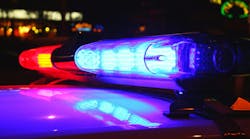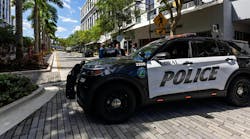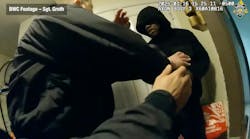A St. Petersburg police officer was fired Wednesday -- and two of his colleagues suspended -- following an April shooting on the city's predominantly black south side that was reminiscent of one that claimed the life of a teenager 17 years ago, sparking the worst race riots in the city's history.
The unusually stern punishments come at a time when the police department has been under fire in the black community for its perceived heavy-handedness. The April shooting, in particular, has rankled, among others, the NAACP, and the police department's tactics have been questioned during recent mayoral debates.
Collectively, the three officers discharged 20 rounds on April 15, as they tried to arrest a 19-year-old man driving a stolen Nissan Altima who had a 15-year-old girl with him. The suspect, Shaquille Sweat, was shot in his shoulder and forearm; his passenger, Tyeisha Long, now 16, was shot in the arm. Both survived.
At issue was whether the officers feared for their lives when they fired at the stolen Altima and where they were in relation to the car at the time.
The police department tightened its policies regarding shooting at cars following two riots in 1996, set in motion after an officer fatally shot a black teenager -- coincidentally, not far from where the April 15 shooting happened -- after the teen repeatedly bumped his car into the officer.
The officer fired Wednesday was George Graves, 30. He had been with the police department since 2008.
Graves admitted that it was possible the Altima was going past him -- as opposed to directly at him -- when he fired, according to an internal affairs case summary released Wednesday. That would be a violation of policy. Officers are supposed to do what they can to stay out of the way of automobiles -- not shoot at them. One of the bullets fired by Graves struck a house.
Graves' testimony didn't square with the evidence in the case, Police Chief Chuck Harmon wrote in a memorandum released Wednesday night. Graves was 90 feet away from the stolen car when he fired, and it wasn't coming at him.
His two colleagues, suspended for 80 hours each, are Brandon Bill, 32, who's been with the police department since 2008, and Richard Bishop, 31, who's been with the department since 2011.
Here's what happened in the shooting, according to the 18-page case summary released Wednesday.
The three officers, part of the street crimes unit, converged on the stolen car shortly before 3 p.m. Bill and Bishop drove up to the stolen car, which had been backed up to the rear of a house at 1831 26th St. S.. Thinking at first the car was unoccupied, they left 14 to 18 feet between their unmarked car and the Altima. Meanwhile, Graves got into position a block away.
When Bill and Bishop got out of their car, they saw Sweat. They immediately drew their weapons and told the occupants to get out, with Bill approaching Sweat's side and Bishop approaching the passenger side, where Long was sitting. Sweat seemed to comply at first, opening his door -- a move that prompted Bishop to start making a wide arc in front of the stolen Nissan, to help Bill. Then Sweat slammed the door shut and hit the accelerator.
By that point, Bishop told internal affairs investigators, he was at the front of the car on the passenger's side; the Altima came toward him, and he fired, fearing he had no escape. Bill said he heard Bishop fire two or three shots.
Then the fleeing car got stuck on a tree a short distance away. Bill ran up on it and told Sweat to get out. When he was a couple of feet away from the rear of the Altima, Sweat put the car in reverse and hit the accelerator again, striking Bill's holster on his right hip. Bill pushed off and started backing away when the car continued to come at him in reverse, placing him against a fence. Not able to back up any farther, Bill said he felt he was about to be "smashed by the car into the fence," and he fired his gun. Bishop also fired at the car again.
Sweat drove forward, put the car in reverse and drove at Bill again for about 15 feet. Bill fired, holding his gun across his body and shooting at the driver's side of the car, the case summary says. Having fired 13 rounds, he had run out of ammunition by that point and was shaking so badly he couldn't unzip a spare magazine from his outer carrier.
The Altima turned in Graves' direction. Graves claimed the Altima was heading toward him from the alley while he was standing in Auburn Street. He said he fired twice while retreating to his unmarked car but that the action happened so quickly he may not have actually been in danger when he fired.
Sweat bailed out of the car soon after but was arrested nearby. Long got out of the car and asked for an ambulance.
Sweat told investigators he didn't cooperate with the officers because he had drugs with him.
"Long did not understand why the officers started shooting so quickly and for so long," the summary says.
In Harmon's memorandum, the chief noted Bishop put had put himself in harm's way by walking in front of the Altima during the initial approach.
He said Bill could have approached the Altima once it was stuck on a tree from a direction that would not have left him trapped against the fence.
As for Graves, Harmon noted his testimony was "very inconsistent" with the evidence in the case.
"He fired two rounds at the vehicle, which was over 90 feet away when he discharged his firearm, and the vehicle was traveling away from him in a 90-degree direction," he said.
"No one was being threatened with death or great bodily harm at the time he discharged his weapon," Harmon wrote.
Harmon and his staff also reviewed a March 8 shooting at 3810 18th Ave. S. Members of the vice and narcotics unit, with the help of the street crimes unit, were about to serve a search warrant when three suspects got into a Toyota Camry and drove toward officers.
Sgt. Shannon Halstead fired at the car, as did two undercover narcotics detectives. One of the undercover detectives was ordered to help out with a revised training video on the advisability of police shooting at cars, while the other has been told to come up with a lesson plan on conducting high-risk search warrants.
Halstead got an employee notice because, among other things, she didn't recognize that "bullets do not immobilize moving motor vehicles," according to a memorandum Harmon released Wednesday.
Copyright 2013 - Tampa Tribune, Fla.
McClatchy-Tribune News Service


